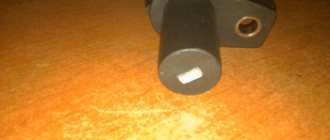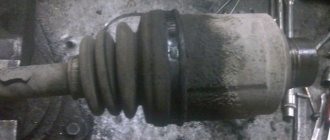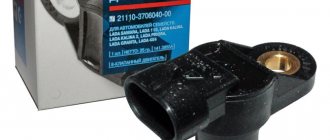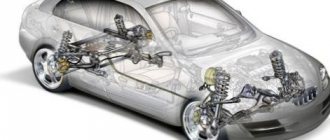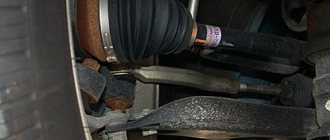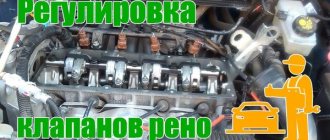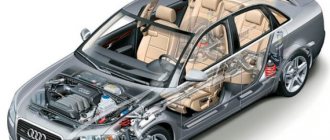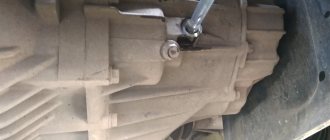What is driveshaft imbalance?
A driveshaft is a part whose center of mass should ideally be on the axis of its rotation. When it shifts relative to the axis (the displacement can be in the horizontal or vertical plane, but most often in the vertical) an imbalance (or imbalance) occurs, which, in turn, causes:
- Violation of rotation uniformity. It manifests itself in the “beating” of the shaft.
- Increased load on transmission elements. Because of this, they wear out faster.
- The occurrence of uncharacteristic noise when the cardan rotates. They are one of the fatcores that allow you to determine the presence of imbalance by ear.
Features of balancing the cardan drive
In the case of a cardan shaft, we are dealing with a part whose length significantly exceeds its diameter, and the imbalance may have the same module, but a different direction vector. This is called moment imbalance and can only be calculated using driveshaft balancing equipment. Such vibrations can only be treated with dynamic balancing, which requires calculating and eliminating several imbalances at once.
An imbalance of the cardan can occur not only due to its damage, but also in some other cases:
- factory defects (different cardan pipe wall thicknesses, poor-quality and incorrect fixation of the lugs);
- the occurrence of gaps in the cardan transmission elements;
- curvature of the shaft itself;
- spline wear.
In addition, in most cases, dynamic balancing of the new cardan is necessary, and after each repair, the cardan shaft must be balanced. The price of this operation in special centers depends on the car model, and the approximate cost of the work is given in the table.
The first symptoms of wheel imbalance
Before wondering where to balance the driveshaft, you need to learn about the most common symptoms of a problem in order to determine in time when you need to take your car to a service center:
- When accelerating to certain speeds, a strong vibration is felt in the car. Moreover, the stronger it becomes, the more the wheels become imbalanced. Strong shaking is dangerous because the car can skid (especially in the winter season).
- Extraneous noises during a trip are also a kind of symbol of the fact that the car is gradually beginning to break down in the area of the cardan and other parts related directly to the vehicle’s chassis system.
Note! Since the driveshaft includes many small parts, they often fail before others. Therefore, it is often necessary to resort to complete replacement of components that are relatively inexpensive. There is no need to skimp on this by trying to manually restore the part, since any intervention can lead to complete failure of the unit.
This is interesting: How to replace the thermostat on a VAZ 21102 with your own hands - useful tips
Cardan balancing: we do it all ourselves
Cardan shaft cross
Cardan imbalance is a very alarming signal. This problem can only be fixed professionally at a service station. But if for some reason you do not have the opportunity to seek help from a specialist, then this article is for you, because balancing driveshafts is an integral part of a high-quality and comfortable ride.
Balancing cardan shafts: all the nuances and repair possibilities
Every experienced motorist knows that vibration of the cardan leads to rapid wear of the entire car, and in particular to wear of the cardan drive. In addition, this problem causes enormous discomfort when driving, which even affects the driver’s well-being. Only balancing the cardan shafts will help eliminate this problem.
Causes of imbalance
There are a huge number of factors that negatively affect the most important part of the transmission. So, cardan balancing is required when:
- Manufacturing defects;
- Impact damage;
- Shaft wear during its operation;
- Poor quality repair of a used shaft, and so on.
It is also worth noting that even a completely new cardan installed on a car simply “requires” adjustment. Unfortunately, cardan balancing is not always carried out properly even at the factory.
Do-it-yourself repair: skillful but temporary balancing of the cardan
Balancing machine for cardan shaft
The best and surest option for a car owner would be a trip to a service station. The modern equipment available there will help you adjust the driveshaft, which is out of balance. Specialists will also diagnose the remaining elements of the assembly. But “traditionally,” vibration catches the car owner at the most inopportune moment, when the nearest service center is hundreds of kilometers away, or when there is simply no way to pay for the services of a specialist, and balancing the driveshaft is simply vital.
In such a situation, you can go in two ways - drive with vibration increasing day by day or make repairs yourself.
Attention. The method described below is only suitable as a “makeshift” solution, and the repair process itself will take you a lot of time
Balancing the cardan is a simple, but very time-consuming task.
As soon as you feel an increase in vibration in your car, try to get to the garage and make the repairs yourself.
- First you need to visually divide the cardan into several sectors, for example into 4. For this you do not need any special equipment.
- Now you need to arm yourself with a small metal weight - 30-40 grams.
- Securely secure the load in one of the designated sectors.
- The next step is to get on a flat road. While driving, you need to understand whether the vibration has decreased or, on the contrary, increased.
- Then we go to the garage again and attach the same load to another sector.
- We return to a flat section of the road and listen to our inner feelings.
Cardan balancing at a service station
Similar manipulations must be repeated with all sections of the cardan. The repair will be of better quality if the cardan is divided into more sectors.
Having decided on the optimal location of the load, you can begin experimenting with its weight. To do this, you need to take loads of different weight categories and attach them one by one. Special equipment, of course, would help make this procedure much faster, but in our case, balancing the cardan is done on our own.
So, having determined the exact weight and exact location, you need to find a metal plate of the required weight and weld it to the pipe. Balancing the cardan with your own hands will allow you to do without special equipment and the help of specialists for at least some time.
You are unlikely to be able to achieve perfect accuracy using this method without using the necessary equipment. At least a small error will still remain, because balancing the cardan is the job of specialists. But such repairs will help you at least for some time not to worry about the safety of all elements of the cardan drive.
Causes of imbalance
The following can contribute to shaft malfunction:
- natural wear of the part during long-term continuous use;
- failure to comply with technical regulations for the use and maintenance of the machine;
- manufacturing defects;
- mechanical damage that occurs when interacting with a solid object, etc.
A sign that an unbalanced condition of the shaft has arisen is an increase in the level of vibration of the cardan when driving to the point of discomfort for the driver and passenger in the car.
When is cardan balancing carried out?
Balancing of this element is carried out in the following cases:
- identification of a manufacturing defect in this part during operation of the vehicle. This does not happen often, however, not a single manufacturer is insured against even a small amount of defects. So, for example, at the BMW company the official percentage of defects is 0.5%, at VAZ this figure is twice as much;
- when replacing a driveshaft caused by its breakdown;
- violation of the technological gaps between the components of the cardan during its assembly and installation on the car (balancing is first carried out on a stand, after which the element is disassembled and balancing is carried out on the car);
- If the driveshaft was installed not in accordance with technological requirements, its alignment may be disrupted. In this case, the cardan is removed and sent back to the balancing stand, after which it is reinstalled on the car;
- The most common reason that the cardan starts to beat is its mechanical damage on the road. Being under the bottom of the car, the cardan can easily be hit by a stone flying from under the wheel, as a result of which its alignment is disrupted;
- theoretically, an imbalance in this part could be the result of corrosion that has changed the geometry of any component of the cardan, or even simple contamination. However, in this case, the imbalance will not be so large as to significantly affect the quality of operation of this mechanism.
How is a driveshaft balanced?
- The cardan is placed on a stand, then special balancing plates are placed on it.
- Gaskets are installed under the locking bearing caps located on the crosspiece.
- Mechanical processing of bosses involves cutting off a certain layer of metal, which causes an imbalance.
The most unpleasant thing that can happen to a cardan shaft is wear of the splines, as well as their seats; in case of critical wear, balancing the cardan is out of the question. There is only one way out - buying new parts and then balancing them.
Diagnostics is a more common occurrence than balancing the driveshaft; most service stations only help identify the problem, but do not solve it. Quite a lot of automakers, along with cardans, install various damper couplings on their cars, as well as elastic rims and suspension supports, which protect the shaft from wear and significantly extend its service life. Therefore, if vibration appears on such cars or a problem arises with the driveshaft, then in most cases the only correct solution is to replace it.
Balancing the cardan at home is impossible, and this should be understood. A good workshop that specializes in providing this type of solution can solve the problem of imbalance, or a frivolous approach to this issue will lead to even bigger problems or additional waste. If the car is equipped with safety couplings and various supports, it is necessary to monitor their condition and, at the slightest defect, seek help, otherwise you will have to change the entire driveshaft, and in more severe cases, a bunch of related parts (gearbox bearings, secondary shaft, etc.). d.).
Temporary elimination of imbalance
The vibration that arises along the way cannot be ignored, so at the first sign you should go to a stand for balancing driveshafts. Being outside the city, it is not always possible to get to a service station with the necessary equipment. In this case, you should perform balancing yourself. The following sequence should be followed:
- Place the car on an overpass or over a hole in the garage, as you will need access to the driveshaft.
- Divide the cardan in half lengthwise.
- Conditionally divide the cardan crosswise into 4 parts. If the car owner has a lot of time, the cardan can be divided into 8 or even 16 parts.
- Take a weight with a weight of up to 30 grams. A piece of lead or a wheel balancer is suitable for these purposes.
- Number the parts of the cardan and attach a weight to the first section.
- Drive onto a flat section of the road and listen to the vibrations.
- Consistently test the car, changing the position of the weight. In this case, it is necessary to find a position in which vibration is minimized.
- By changing the weight of the weight, you need to ensure that there is no vibration in the car interior. At the same time, visual elimination of interior rattling does not mean the complete elimination of parasitic loads on the cardan. At the first opportunity, you need to balance the cardan using special equipment; you need to visit a service station.
- Secure the weight using welding or glue.
This is interesting: Low beam lamps in the headlights of a Renault Megane 2 car: types of bulbs, replacement instructions
By balancing the shaft, the car owner will protect the car from serious repairs. Traffic safety will also increase, since the vibration transmitted into the cabin significantly distracts and irritates the driver.
Professional cardan balancing
Since the length of the shaft significantly exceeds the thickness, moment imbalance may occur.
It can only be calculated using the sensors equipped on the machine for balancing cardan shafts.
The accuracy of the operations performed depends on the technical level of the equipment and the knowledge of the operating personnel. Therefore, balancing should be performed only by trusted service stations.
Balancing is performed as follows:
- The shaft rotates around its axis.
- The sensors touch the surface at control points.
- The working element is displaced.
- The computer displays information about the imbalance in a specific section.
- Special plates are applied in the calculated locations.
- In particularly advanced cases and due to manufacturing defects, metal cutting may be required.
Special equipment allows balancing to be carried out in a short time. And the accuracy of such balancing will be an order of magnitude higher than eliminating the imbalance yourself.
While operating the car, it is important to listen to all extraneous noise and vibrations. The sooner the driveshaft imbalance is detected and corrected, the fewer consequences there will be for your iron friend.
Technological repair method
If you don’t mind 5 thousand rubles for such a task, this is exactly the price of balancing the shaft in a workshop, then we recommend going to specialists. Carrying out diagnostics in repair shops involves using a special stand for dynamic balancing. To do this, the driveshaft is removed from the machine and installed on it. The device includes several sensors and so-called control surfaces. If the shaft is unbalanced, then when rotating it will touch the mentioned elements with its surface. This is how geometry and its curvatures are analyzed. All information is displayed on the monitor.
Repair work can be carried out using various methods:
- Installation of balancer plates directly on the surface of the propeller shaft. At the same time, their mass and installation location are accurately calculated by a computer program. And they are attached using factory welding.
- Balancing the driveshaft on a lathe. This method is used in case of significant damage to the element geometry. Indeed, in this case, it is often necessary to remove a certain layer of metal, which inevitably leads to a decrease in the strength of the shaft and an increase in the load on it in normal operating modes.
This is interesting: How to replace the cabin filter of a Hyundai Solaris yourself: step-by-step instructions, where it is located
It is impossible to make such a machine for balancing cardan shafts with your own hands, since it is very complicated. However, without its use, it will not be possible to perform high-quality and reliable balancing.
It is quite possible to balance the cardan yourself at home. However, it is necessary to understand that it is impossible to independently select the ideal mass of the counterweight and its installation location. Therefore, self-repair is possible only in case of minor vibrations or as a temporary method of getting rid of them. Ideally, you need to go to a service station, where you will have the cardan balanced on a special machine.
Balancing the cargo cardan
Gazelle driveshaft outboard bearing
Cargo driveshafts differ from others at least in size. The average weight of such a cardan shaft is 80 kg or more. Balancing a driveshaft of such mass can be dangerous, since we carry it out at speeds above 5000 rpm. This requires special care as it poses a danger not only to the equipment, but also to people nearby.
The longer the driveshaft, the easier it is to balance, provided it is assembled mechanically correctly. Long is from 1.5 meters. All universal joints in short require particularly precise mechanical assembly and high-precision careful balancing. This is due to its mechanical rigidity. If we consider it as an elastic beam, the cargo cardan has the highest rigidity due to the high torque; it is designed with a high margin of safety and is made of stronger steels, for example, some American manufacturers use cast iron with a high modulus of elasticity.
First, the quality of the pipe is checked: is it deformed or not. There is a relatively simple way to do this. Using chalk. The pipe rotates, a piece of chalk is placed against it, which leaves marks. They show all the irregularities in the pipe. You can also measure the pipe with a caliper 100 mm from the weld. A difference in pipe diameter when rotated 90 degrees means that it is deformed and requires replacement.
After making sure that the pipe is straight, you need to check the splines of the driveshaft. Play in the splines is unacceptable. Because If the play is more than 0.2mm, balancing of the cargo cardan is impossible. If there is no money at all and the situation is hopeless, you can try to eliminate the strongest vibrations, but it is impossible to completely eliminate vibration on such a spline. Just as it is impossible to balance a rubber hose - the spline constantly jumps between extreme positions and the imbalance in this case is caused by a mechanical displacement of the masses in the spline pair. You can check the spline joint by filling it with lubricant, for example lithol, through an oil can. If the vibration disappears (of course, in this case not for long), then the spline has exhausted its service life and requires immediate replacement.
Balancing the cargo cardan also requires checking the crosspieces, which may have the following faults: axial or radial play, biting, uneven rotation, bent forks and jammed crosspieces in the axes of rotation.
Another important malfunction that can prevent you from balancing the cargo driveshaft is when hammers hit the flanges of the gearbox and the driveshaft itself when trying to remove or install the shaft in place. It is unacceptable! A small hammer blow to the flange seat will cause a large imbalance.
Crosspieces from cheap and incompetent manufacturers, as a rule, are easily pressed, allow water to pass through the anthers and quickly fail. But the saddest thing is that the crosspiece begins to rotate not in the bearing, but in the seating area, that is, in the eye of the flanges and propeller shaft. This causes wear, rubbing, chipping of the metal, wearing out of the lugs and ultimately their unraveling, breakage and destruction of the driveshaft when the car is moving. Even if the driveshaft does not fall off while driving, you will have to buy another, completely new one. Even a few hours of running on such crosspieces will make it impossible to install even high-quality crosspieces. The seat will be irreversibly damaged. Buying a new cardan, as cheap as the crosspiece, leads to the same sad result. We wrote about how to distinguish a good cardan shaft here.
Car operating rules
In order for the driveshaft to last longer, you must follow some rules that will help the part be subjected to less stress during operation:
- Try to limit driving on uneven roads, as constant shaking will negatively affect the geometry of the driveshaft.
- Drive away smoothly, avoiding unnecessary slipping and sudden starts, which significantly increase the load on the vehicle's chassis.
- Once you get into a hole, try to get out of it smoothly, without rocking the car. Carry special mats with you to place under the wheels to minimize the risk of breaking the chassis or driveshaft.
- Do not shift gears abruptly to reduce the load on the special elastic coupling.
- Contact a car service in a timely manner for a complete diagnosis of the vehicle, as well as for advice on car repair and maintenance.
- Do not wash driveline components with high pressure, as water may enter the system;
- Do not heat the shaft when trying to remove old paint - this will disrupt the uniformity of the metal;
- Periodically check the tightness of the fasteners to prevent them from loosening and increasing the load on the moving parts.
- Use lubricants recommended by the manufacturer to protect connections from wear due to sliding.
- Avoid excessive loads on the transmission and driving at high speeds.
Sources
- https://kardanvalservis.ru/articles/chto-takoe-disbalans-kardannogo-vala/
- https://AvtoShef.com/balansirovka-kardannogo-vala-svoimi/
- https://razborkadonskoe.ru/ustrojstvo/balansirovka-kardannogo-vala-osnovnye-metody-kak-otbalansirovat-kardan-svoimi-rukami.html
- https://dns-kardan.ru/balansirovka_kardannogo_vala_svoimi_rukami.php
- https://avtopulsar.ru/chto-takoe-balansirovka-kardannogo-vala-priznaki-i-prichiny-disbalansa-kardana/
- https://carwin-motors.ru/remont/balansirovka-kardannogo-vala-osnovnye-metody-kak-otbalansirovat-kardan-svoimi-rukami.html
[collapse]
Causes of driveline vibration
- Play in the bearings of the crosspieces exceeds the permissible values. This malfunction, as well as the next one on the list, is eliminated by replacing the cross that has become unusable.
- Loss of mobility of crosspiece needle bearings due to corrosion. You can detect this defect with your own hands if, before repair, you disconnect the fastening of at least one end of the cardan drive from the transmission flanges and try to move the free end to the side.
- Deep cracks in the elastic coupling. Repair consists of replacing this part.
- Misalignment of the crosspieces after alteration of the driveshaft or due to incorrect assembly of the unit with two crosspieces at the edges and a splined connection between them. For repairs, restore the alignment of the hinges.
- Loosening of the flanges of the cardan and the axle gearbox.
- Unscrewing the nut securing the flange to the gearbox shank.
- Suspension bearing failure.
- Excessive spline play.
- Deformation of the cardan transmission pipe.
Balancing the VAZ 2107 driveshaft
If vibration occurs due to an imbalance in the driveshaft, it will need to be balanced. It is problematic to do this on your own, so they usually turn to a car service. Balance the cardan as follows.
- The cardan shaft is installed on a special machine, on which a number of parameters are measured.
- A weight is attached to one side of the gimbal and tested again.
- Measure the parameters of the cardan with a weight attached to the opposite side.
- The shaft is turned over 180˚ and the measurements are repeated.
The results obtained make it possible to balance the cardan by welding weights into the places established according to the measurement results. After this, the balance is checked again.
Video: balancing the cardan
Craftsmen have figured out how to balance the VAZ 2107 cardan with their own hands. The procedure is as follows:
- The driveshaft is conventionally divided into four equal parts, after driving the car into a pit or overpass.
- A weight weighing about 30 g is attached to the first part of the cardan and testing is carried out.
- Drive out onto a road with a smooth surface and check whether the vibration has decreased or increased.
- The actions are repeated with a weight attached to another part of the cardan.
- After identifying the problematic part of the cardan, select the weight of the weight. To do this, the car is tested on the move with weights of different weights. When the vibration disappears, the weight is welded to the cardan.
When balancing the cardan, a weight is selected experimentally and, after the vibration disappears, it is welded
Obviously, it will not be possible to achieve high balancing accuracy using the traditional method.
Repairing a VAZ 2107 driveline transmission is not particularly difficult even for inexperienced car owners. All you need is desire, free time, a minimum set of plumbing tools and careful adherence to the instructions of specialists.
Basic provisions for rotor balancing
Balancing the rotor on a machine is the operation of combining the axes of rotation and inertia of the rotor, determined and controlled during the rotation of the rotor installed on the balancing machine.
Balancing the rotor at the site of operation of the unit (on-site balancing) is an operation to reduce the vibration of the unit at the rotor speed by installing balancing masses on the rotating parts in accessible correction planes. On-site balancing can be performed to ensure the required vibration either for one (typical) operating mode of the unit (rotation speed, load, etc.), or for several predetermined operating modes.
In the ideal case - when an unbalanced rotor rotates on a balancing machine - only centrifugal forces act on it at the frequency of its rotation due to the displacement of the axis of inertia relative to the axis of rotation. The unbalance of the rotor is characterized by the values of eccentricity e or imbalance me , where m is the mass of the rotor. Since the rotor imbalance can be the sum of the static and torque components, see Fig. 12.2. quantitative characteristics of imbalance can be divided into two components with reference to each correction plane or rotor rotation support.
Fig. 12.2. Types of rotor imbalance - static, moment, dynamic. Heavy points of the rotor are darkened, light points of the rotor (locations for installing balancing masses) are indicated by circles with numbers.
The rigidity of the rotor (or its shaft or bearings) is finite, and during rotation the centrifugal force deforms it, creating an additional imbalance, which adds up to the initial imbalance and grows with increasing rotor speed. There is, however, a rotor speed called critical, after which the direction of additional rotor imbalance is reversed. In this case, the total imbalance of the rotor decreases sharply, the rotor begins to rotate around the axis of inertia, but the geometric axis retains the deformation, i.e. the shaft “beats” in the bearings by the amount of the initial eccentricity. This effect is called rotor autobalancing and is used in the design of high-speed machines to reduce vibration at operating speed. At the same time, the need to balance the flexible rotor remains, and its task is to reduce shaft damage in bearings. The rotor of such machines is called flexible, and the rotor is always classified as flexible if its critical rotation speed is lower than 1.25 of its operating speed.
The rotor auto-balancing effect is also used in the most common over-resonance balancing machines in which low-rigidity rotation supports are installed. In such machines, the task of balancing at supercritical rotation speeds is to reduce the “break” of the shaft in each of the supports. However, when balancing a flexible rotor like a rigid one, a number of issues of its balancing at rotation speeds close to critical are not resolved.
If the initial imbalance is static, then the additional one due to the deflection of the shaft is also static (Figure 12.3.), and it will begin to be compensated after the first critical speed; with momentary imbalance, auto-balancing will begin after the second critical speed, which is approximately 4 times higher than the first. The rotors of high-speed machines are usually designed so that the first critical speed is below the rotor speed, and the second is in the middle between the first and second harmonics of the rotation speed. Thus, the relationship between static and torque imbalance begins to depend on the rotor speed. Accordingly, even on balancing machines, when dynamically balancing such rotors, difficulties arise that, when balancing on site, can be easily overcome only by using multi-channel vibration measuring systems, special diagnostic algorithms and rotor balancing programs for multi-mode mechanisms.
Fig. 12.3. Rotor deflection shape at the first and second critical rotation speeds



